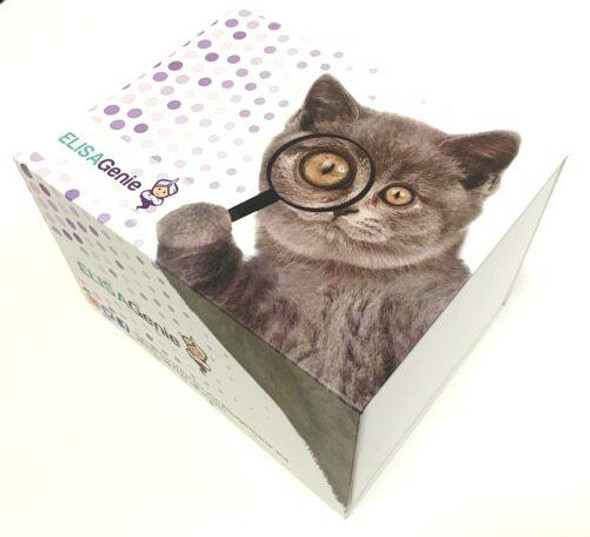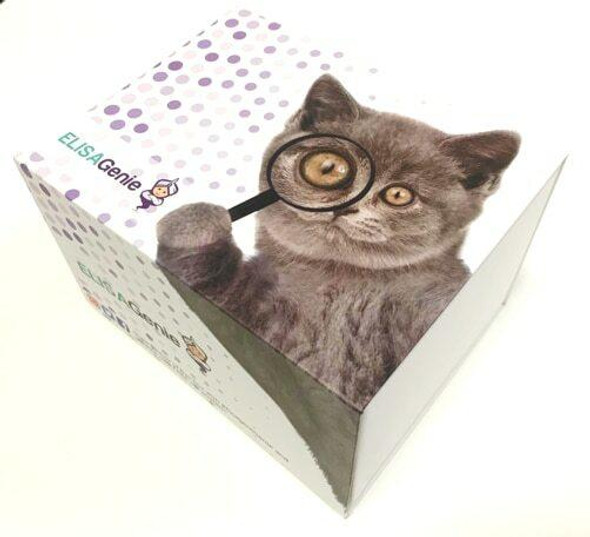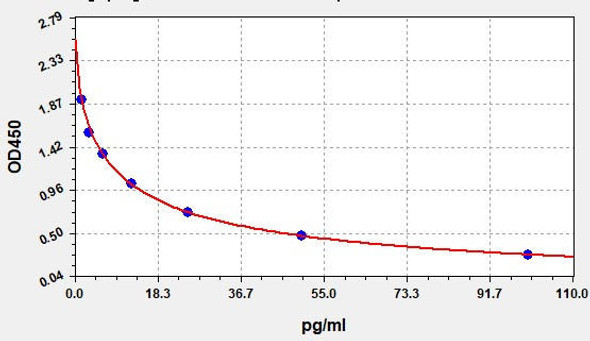Human Cell Biology ELISA Kits 6
Human CRH (Corticotropin Releasing Hormone) ELISA Kit (HUES02230)
- SKU:
- HUES02230
- Product Type:
- ELISA Kit
- Size:
- 96 Assays
- Uniprot:
- P06850
- Sensitivity:
- 2.35pg/mL
- Range:
- 3.91-250pg/mL
- ELISA Type:
- Competitive
- Synonyms:
- CRF, Corticoliberin
- Reactivity:
- Human
- Sample Type:
- Serum, plasma and other biological fluids
- Research Area:
- Cell Biology
Description
| Assay type: | Competitive-ELISA |
| Format: | 96T |
| Assay time: | 2.5h |
| Reactivity: | Human |
| Detection Method: | Colormetric |
| Detection Range: | 3.91-250 pg/mL |
| Sensitivity: | 2.35 pg/mL |
| Sample Volume: | 50µL |
| Sample Type: | Serum, plasma and other biological fluids |
| Specificity: | This kit recognizes Human CRH in samples. No significant cross-reactivity or interference between Human CRH and analogues was observed. |
This ELISA kit uses Competitive-ELISA as the method. The microtiter plate provided in this kit has been pre-coated with Human CRH. During the reaction, Human CRH in the sample or standard competes with a fixed amount of Human CRH on the solid phase supporter for sites on the Biotinylated Detection Ab specific to Human CRH. Excess conjugate and unbound sample or standard are washed from the plate, and Avidin conjugated to Horseradish Peroxidase (HRP) are added to each microplate well and incubated. Then a TMB substrate solution is added to each well. The enzyme-substrate reaction is terminated by adding Stop Solution and the color change is measured spectrophotometrically at a wavelength of 450 nm ± 2 nm. The concentration of Human CRH in the samples is then determined by comparing the OD of the samples to the standard curve.
| UniProt Protein Function: | CRH: This hormone from hypothalamus regulates the release of corticotropin from pituitary gland. Belongs to the sauvagine/corticotropin-releasing factor/urotensin I family. |
| UniProt Protein Details: | Protein type:Secreted, signal peptide; Secreted Chromosomal Location of Human Ortholog: 8q13 Cellular Component: extracellular space; cytoplasm; extracellular region; perikaryon Molecular Function:corticotropin-releasing hormone receptor 1 binding; neuropeptide hormone activity; protein binding; hormone activity; corticotropin-releasing hormone receptor 2 binding; adrenocorticotropin-releasing hormone activity; receptor binding Biological Process: negative regulation of circadian sleep/wake cycle, REM sleep; diterpenoid metabolic process; synaptic transmission, dopaminergic; hypothalamus development; positive regulation of cortisol secretion; induction of apoptosis by hormones; response to pain; female pregnancy; signal transduction; positive regulation of adrenocorticotropic hormone secretion; negative regulation of luteinizing hormone secretion; synaptic transmission; learning and/or memory; positive regulation of cell proliferation; positive regulation of cAMP biosynthetic process; feeding behavior; negative regulation of blood pressure; parturition; inflammatory response; response to electrical stimulus; associative learning; response to corticosterone stimulus; response to drug; adrenal gland development; response to ether; response to ethanol; long-term memory; response to estrogen stimulus; ion homeostasis; regulation of serotonin secretion; negative regulation of epinephrine secretion; positive regulation of protein amino acid phosphorylation; glucocorticoid biosynthetic process; lung development Disease: Acth Deficiency, Isolated |
| NCBI Summary: | Corticotropin-releasing hormone is secreted by the paraventricular nucleus (PVN) of the hypothalamus in response to stress. Marked reduction in this protein has been observed in association with Alzheimer disease and autosomal recessive hypothalamic corticotropin deficiency has multiple and potentially fatal metabolic consequences including hypoglycemia and hepatitis. In addition to production in the hypothalamus, this protein is also synthesized in peripheral tissues, such as T lymphocytes and is highly expressed in the placenta. In the placenta it is a marker that determines the length of gestation and the timing of parturition and delivery. A rapid increase in circulating levels of the hormone occurs at the onset of parturition, suggesting that, in addition to its metabolic functions, this protein may act as a trigger for parturition. [provided by RefSeq, Apr 2010] |
| UniProt Code: | P06850 |
| NCBI GenInfo Identifier: | 117445 |
| NCBI Gene ID: | 1392 |
| NCBI Accession: | P06850. 1 |
| UniProt Secondary Accession: | P06850,B3KQS4, |
| UniProt Related Accession: | P06850 |
| Molecular Weight: | 196 |
| NCBI Full Name: | Corticoliberin |
| NCBI Synonym Full Names: | corticotropin releasing hormone |
| NCBI Official Symbol: | CRH |
| NCBI Official Synonym Symbols: | CRF; CRH1 |
| NCBI Protein Information: | corticoliberin; corticotropin-releasing factor |
| UniProt Protein Name: | Corticoliberin |
| UniProt Synonym Protein Names: | Corticotropin-releasing factor; CRF; Corticotropin-releasing hormone |
| Protein Family: | Corticoliberin |
| UniProt Gene Name: | CRH |
| UniProt Entry Name: | CRF_HUMAN |
As the OD values of the standard curve may vary according to the conditions of the actual assay performance (e. g. operator, pipetting technique, washing technique or temperature effects), the operator should establish a standard curve for each test. Typical standard curve and data is provided below for reference only.
| Concentration(pg/mL) | O.D | Average |
| 250 | 0.365 0.373 | 0.369 |
| 125 | 0.474 0.492 | 0.483 |
| 62.5 | 0.705 0.675 | 0.69 |
| 31.25 | 1.007 1.037 | 1.022 |
| 15.63 | 1.472 1.444 | 1.458 |
| 7.81 | 1.909 1.901 | 1.905 |
| 3.91 | 2.254 2.264 | 2.259 |
| 0 | 2.739 2.747 | 2.743 |
Precision
Intra-assay Precision (Precision within an assay): 3 samples with low, mid range and high level Human CRH were tested 20 times on one plate, respectively.
Inter-assay Precision (Precision between assays): 3 samples with low, mid range and high level Human CRH were tested on 3 different plates, 20 replicates in each plate.
| Intra-assay Precision | Inter-assay Precision | |||||
| Sample | 1 | 2 | 3 | 1 | 2 | 3 |
| n | 20 | 20 | 20 | 20 | 20 | 20 |
| Mean (pg/mL) | 2.10 | 5.90 | 17.20 | 2.20 | 5.30 | 16.30 |
| Standard deviation | 0.10 | 0.30 | 0.70 | 0.10 | 0.20 | 0.50 |
| C V (%) | 4.76 | 5.08 | 4.07 | 4.55 | 3.77 | 3.07 |
Recovery
The recovery of Human CRH spiked at three different levels in samples throughout the range of the assay was evaluated in various matrices.
| Sample Type | Range (%) | Average Recovery (%) |
| Serum (n=5) | 94-107 | 100 |
| EDTA plasma (n=5) | 94-109 | 100 |
| Cell culture media (n=5) | 94-105 | 100 |
Linearity
Samples were spiked with high concentrations of Human CRH and diluted with Reference Standard & Sample Diluent to produce samples with values within the range of the assay.
| Serum (n=5) | EDTA plasma (n=5) | Cell culture media (n=5) | ||
| 1:2 | Range (%) | 91-104 | 91-105 | 94-110 |
| Average (%) | 96 | 98 | 101 | |
| 1:4 | Range (%) | 87-100 | 91-104 | 95-110 |
| Average (%) | 93 | 97 | 103 | |
| 1:8 | Range (%) | 87-100 | 93-107 | 95-113 |
| Average (%) | 95 | 99 | 103 | |
| 1:16 | Range (%) | 87-98 | 92-106 | 94-107 |
| Average (%) | 92 | 100 | 101 |
An unopened kit can be stored at 4°C for 1 month. If the kit is not used within 1 month, store the items separately according to the following conditions once the kit is received.
| Item | Specifications | Storage |
| Micro ELISA Plate(Dismountable) | 8 wells ×12 strips | -20°C, 6 months |
| Reference Standard | 2 vials | |
| Concentrated Biotinylated Detection Ab (100×) | 1 vial, 120 µL | |
| Concentrated HRP Conjugate (100×) | 1 vial, 120 µL | -20°C(shading light), 6 months |
| Reference Standard & Sample Diluent | 1 vial, 20 mL | 4°C, 6 months |
| Biotinylated Detection Ab Diluent | 1 vial, 14 mL | |
| HRP Conjugate Diluent | 1 vial, 14 mL | |
| Concentrated Wash Buffer (25×) | 1 vial, 30 mL | |
| Substrate Reagent | 1 vial, 10 mL | 4°C(shading light) |
| Stop Solution | 1 vial, 10 mL | 4°C |
| Plate Sealer | 5 pieces | |
| Product Description | 1 copy | |
| Certificate of Analysis | 1 copy |
- Set standard, test sample and control (zero) wells on the pre-coated plate and record their positions. It is recommended to measure each standard and sample in duplicate. Note: add all solutions to the bottom of the plate wells while avoiding contact with the well walls. Ensure solutions do not foam when adding to the wells.
- Add 50 µL of Standard, Blank or Sample to their respective wells. The blank well is added with Sample / Standard dilution buffer.
- Immediately add 50 µL of Biotin-detection antibody working solution to each well.
- Cover with a plate seal and gently tap the plate to ensure thorough mixing. Incubate for 45minutes at 37 °C.
- Aspirate or decant the solution from the plate and add 350 µL of wash buffer to each welland incubate for 1-2 minutes at room temperature. Aspirate the solution from each well andclap the plate on absorbent filter paper to dry. Repeat this process 3 times. Note: a microplatewasher can be used in this step and other wash steps.
- Add 100 µL of HRP Conjugate working solution to each well and over with a plate seal. Incubate for 30 minutes at 37 °C.
- Repeat the aspiration/wash process 5 times according to step 5.
- Add 90 µL of the Substrate reagent to each well and cover with a new plate seal. Incubatefor approximately 15 minutes at 37 °C and protect from light. The reaction time can beshortened or extended according to the colour change, but not by more than 30 minutes. Whenapparent gradient appears in standard wells, terminate the reaction.
- Stop: Add 50 µL of Stop Solution to each well (wells will develop a yellow color immediately). Note: Adding the stop solution should be done in the same order as the substrate solution.
- Determine the optical density (OD value) of each well immediately with a microplate readerset at 450 nm. In advance, preheat the instrument and set the testing parameters.






